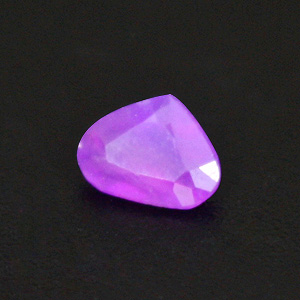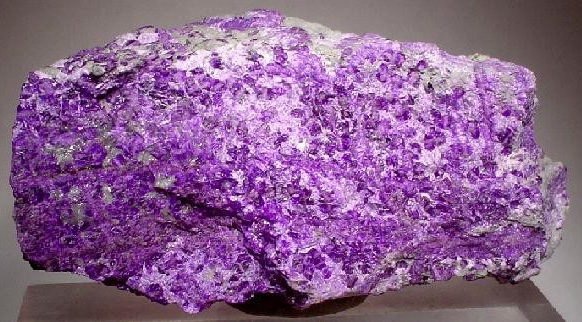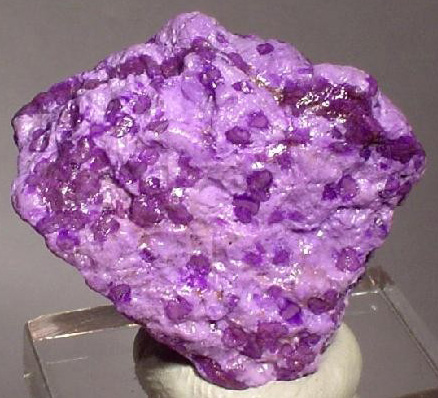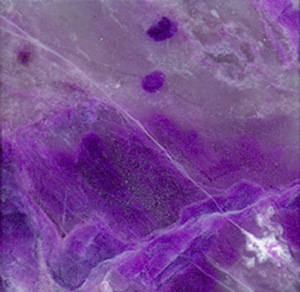Sugilite
Sugilite is an uncommon cyclosilicate mineral known for its unusual, rich pink-purple color. It has the chemical formula KNa2(Fe,Mn,Al)2Li3Si12O30 and a hardness of around 6 (5.5-6.5) on the Mohs scale. [1] Sugilite is most often found in massive form (i.e. a shapeless mass with no defined crystal shape [2] ) however it does sometimes form small crystals.[1]

Sugilite Gemstone
From Hotazel, South Africa.
0.08 carat; 3.8 x 2.9 x 1.5mm
Image © supplied by Freakingcat Gems
True gem grade, crystalline sugilite is rare and most sugilite gemstones available today are shaped from massive. These often contain swirls of varied color - or even blotches of yellow, black or brown - and if these patches are large enough it's possible to cut the stone so as to be a "yellow sugilite" etc. Sugilites with the best purple color, desirable patterning and least patches of other colors are typically considered the most valuable. [3]
Sugilite was first discovered by Ken-ichi Sugi in Japan and was described in 1944. However, the early sugilite found was not of gem quality and it did not truly enter the world of gemstones until the 1970's when gem quality sugilite was found deep underground in the Kalahari Manganese mines of South Africa. Sugilite has grown quite popular in recent years.
Sugilite has also been sold by the names "Luvulite", "Royal Lavulite", Royal Azel", "Royal Lazelle" [3] or "purple turquoise" - although despite some superficial similarity, the stone is not related as a mineral to turquoise. [4] In addition to being found in Japan, sugilite has also been discovered in Australia (New South Wales), Canada, Italy, Tajikistan, and Northern South Africa, which has been the most significant source of gem quality sugilite. [5]
Sugilite has been found in association with richterite, a blue mineral - and some gemstones contain both these minerals in an attractive combination of blue and purple.
Looking around online (Jan 2011) there is much "regular grade" opaque sugilite available in the form of cabochons and these can be obtained relatively inexpensively - with stones in the 8-30 carat range having been observed retailing at around $10 per carat. It's also possible to buy sugilite in the form of beads, sugilite spheres, tear drops, heart shapes, sugilite pebbles or other. One can also obtain uncut material, and I have seen 40 grams of sugilite rough for less than $40.
Most of the sugilite found is opaque. High grade, translucent sugilite sells for much higher prices and is rare. $50 or more per carat is not that uncommon for fine sugilite. The very best stones are those with the best translucency, rich / deep coloring and with a "gel" appearance - and these, sometimes known as sugilite gel may fetch over $500 per carat.
Sugilite Images

Sugilite
From Hotazel, South Africa. Size: 8.0 x 3.7 x 3.0 cm.
Photo by Rob Lavinsky, iRocks.com lic. under CC-BY-SA-3.0

Tumbled Sugilite
Tumbled sugilite pebble

Uncut Sugilite
From Hotazel, South Africa. Size: 3.0 x 2.8 x 1.3 cm.
Photo by Rob Lavinsky, iRocks.com lic. under CC-BY-SA-3.0

Sugilite Tile
Sugilite - Sources Referenced:
[1] http://en.wikipedia.org/wiki/Sugilite
[2] http://en.wikipedia.org/wiki/Crystal_habit
[3] http://www.bernardine.com/gemstones/sugilite.htm
[4] http://www.gemselect.com/other-info/purple-sugilite.php
[5] http://www.mindat.org/min-3822.html
Back to the Gemstones List home page - over 160 gemstones explored!
Please feel free to link to this page - copy / paste the text below: (click to select)
Privacy Policy | Cookie Policy | GDPR | About This Site / Terms

© gemstoneslist.com


